TO
Filters: Publication Type: "presentation" Collection: "ir_eua" School Or College: "University of Utah"
| Title | Date | Subject | Description | ||
|---|---|---|---|---|---|
| 1 |
 |
Development of HPC-based simulations tool for in situ thermal processing of oil shale/sands | HPC-based simulations tool; in situ thermal processing; oil shale; oil sands; commercial production of oil shale; ecoshale in-capsule process | A presentation given at the Unconventional Fuels from Oil Shale and Oil Sands Project Review Meeting on March 10-11, 2011. | |
| 2 |
 |
Recovery of bitumen from oil-impregnated sandstone deposits of Utah | 1975-11 | potential oil; bitumen; oil-impregnated sandstone (tar sand) deposits; tar sands; bitumen recovery | Utah contains at least 26 billion barrels of potential oil as bitumen in oil-impregnated sandstone (tar sand) deposits. As shown in this paper, these tar sands are significantly different in physical and chemical properties from commercially developed Canadian tar sands. These differences prevent di... |
| 3 |
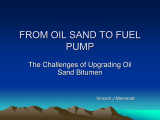 |
From oil sand to fuel pump: The challenges of upgrading oil sand bitumen | 2006-09-21 | oil sand; upgrading oil sand bitumen; oil sand bitumen; oil sands development; crude; bitumen | Oil sands development--develop a resource that has market value. |
| 4 |
 |
In situ production of Utah oil sands | 2008-03-12 | in situ; Utah oil sands; oil sands production; tar sand deposits; Whiterocks eolian sandstone | |
| 5 |
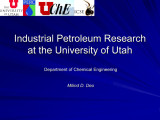 |
Industrial petroleum research at the University of Utah | 2008-03-12 | industrial petroleum; University of Utah; oil and gas characterization; oil and gas thermodynamics; Unconventional Consortium | Expertise: Oil and Gas Characterization, Hydrocarbon Thermodynamics -High-temperature, high high-pressure oil oil-gas mixtures -Supercritical extraction -Solid (asphaltenes, waxes) precipitation precipitation -Reservoir Characterization and Simulation -Fractured reservoir simulation -Reaction chemis... |
| 6 |
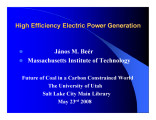 |
High efficiency electrical generation | 2008-05-23 | efficiency of electrical generation; electrical generation; fossil fuel energy resources; mitigatint GHG emissions; CO2 capture and sequestration | Outline: 1-Electricity outlook and fossil fuel energy resources. 2-Technology options for mitigating GHG emissions. 3-CO2 cpature and sequestration. 4-Costs. 5-Concluding remarks. |
| 7 |
 |
KTIA corporate introduction | 2009-02-27 | KTIA; KTI; mines | Overview of KTIA's continuing oil sands development activities in Utah, presented at the 2009 Western U.S. Oil Sands Conference by Soung-Joon Kim, Chief Operating Officer, Korea Technology Industry America, Inc. |
| 8 |
 |
Welcome and Introduction: 2009 Western U.S. Oil Sands Conference | 2009-02-27 | oil sands industry; industrial combustion; gasification technology research; CO2 capture technologies; coal; OxyFuel Combustion; chemical looping; gasification; oil shale/sands | Summary of challenges facing U.S. oil sands industry and the role of the Institute for Clean and Secure Energy at the University of Utah in addressing those challenges, presented at the 2009 Western U.S. Oil Sands Conference by Philip Smith, Professor, Department of Chemical Engineering and Director... |
| 9 |
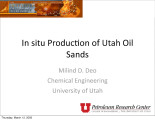 |
In situ production of Utah oil sands | 2009-02-27 | in situ; oil sands production; Utah oil sands; in situ process; thermal simulator; thermal compositional model; steam assisted gravity drainage; SAGD; heterogenetics; in-situ combustion; hydraulic fracture; hybrid process | Analysis of issues relevant to in situ production of Utah oil sands, presented at the 2009 Western U.S. Oil Sands Conference by Milind Deo, Professor, Department of Chemical Engineering, University of Utah. |
| 10 |
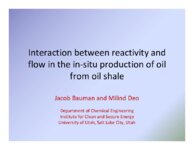 |
Interaction between reactivity and flow in the in-situ production of oil from oil shale | 2009-10-23 | in situ; oil shale | In-situ Oil Shale Processing: 1) Underground resources are heated by some means to convert insoluable/ impermeable kerogen into oil and gas products. 2) The interlinked processes of heat transfer, kerogen conversion and flow are complex. 3) This paper is an attempt to understand these linkages. |
| 11 |
 |
Digital library and interactive map projects at the Institute for Clean and Secure Energy, University of Utah | 2009-10-23 | ICSE; digital repository | The Instituteʼs repository is a not-for-profit service for researchers, and we are working to include a variety of documents, data, and maps relevant to unconventional fuels research and development. |
| 12 |
 |
High-pressure, entrained flow gasification hierarchy | 2009-11-04 | gasification hierarchy; entrained flow; high-pressure gasification | Hierarchical chart for the high-pressure, entrained flow gasification research area showing connectivity between subtasks. This chart helps illustrate gasification integration and focus and also serves as a management tool for the various subtasks. Subtasks in brown and orange are currently funded t... |
| 13 |
 |
Pore scale analysis of oil sand/oil shale pyrolysis by X-ray Micro CT and LB simulation | 2010-03-03 | pore scale analysis; oil sand/shale pyrolysis; X-ray Micro CT and LB simulation; Lamellar Structure of Oil Shale | The research objectives include (1) CT characterization of the pore network structure for selected oil sand/oil shale resources, (2) LB simulation of flow through pore network structures to predict transport properties, such as permeability, and (3) CT analysis of pore network structure during pyrol... |
| 14 |
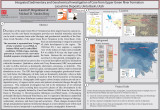 |
Integrated sedimentary and geochemical investigation of core form the upper Green River Formation lacustrine deposits, Uinta Basin, Utah | 2010-04-12 | upper Green River formation; lacustrine deposits; geochemical investigation; lithofacies; facies | Description of the upper Green River Formation has been largely based on outcrop exposures, but this core-based investigation provides newly detailed subsurface data that can be used to examine basin-wide lithologic and geochemical variability of he Parachute Creek Member of the upper Green River Fo... |
| 15 |
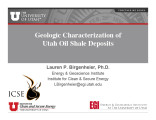 |
Geologic characterization of Utah oil shale deposits | 2010-04-28 | oil shale development; geologic framework; lake evolution; oil shale; stratigraphic correlation | Why Geology? Economic prospectivity of oil shale development in the Uinta Basin relies heavily on establishing a solid geologic framework. Understanding lake evolution matters. |
| 16 |
 |
Federal control of greenhouse gas emissions | 2010-04-28 | greenhouse gas emissions; federal control efforts; domestic legislation | Federal Control Efforts: 1) International 2) New Domestic Legislation 3) Using Existing Domestic Legislation |
| 17 |
 |
Oxy-gas process heaters for efficient CO2 capture | 2010-04-28 | oil shale and oil sands technology; greenhouse gas emissions; GHG; large eddy simulation; LES; IFRF OXYFLAM | Implementation of oil shale/sands technologies in U.S. will require mitigation of greenhouse gas (GHG) emissions. |
| 18 |
 |
Evaluating opportunities for reducing life-cycle, well-to pump GHG emissions from conventional and unconventional fuels | 2010-04-28 | unconventional fuels; GHG emissions; conventional fuels; reducing life-cycle; oil shale; oil sands; coal | Resource extraction and upgrading. |
| 19 |
 |
Pore scale analysis of oil sand/oil shale pyrolysis by X-ray Micro CT and LB simulation | 2010-04-28 | unconventional fuels; characterization of the pore networks; oil sand/shale resources; LB simulation; pyrolysis reations; Multiscale X-ray Micro/Nano Tomography | The research objectives include (1) CT characterization of the pore network structure for selected oil sand/oil shale resources, (2) LB simulation of flow through pore network structures to predict transport properties, such as permeability, and (3) CT analysis of pore network structure during pyrol... |
| 20 |
 |
SO3 formation during oxy-coal combustion - Presentation | 2010-06-10 | SO3; oxy-coal combustion; controlled condensation method; sulfur combustion; pilot-scale combustor | In oxy-coal combustion, an oxygen and carbon dioxide mixture, rather than air, is used to burn the coal. Many studies to date have focused on the formation of NOx under oxy-coal combustion conditions; however, the formation of sulfur species, particularly sulfur trioxide, is currently not a wellunde... |
| 21 |
 |
Ignition in 40kw co-axial turbulent diffusion oxy-coal jet flames | 2010-08-08 | 40kw co-axial turbulent diffusion; diffusion; oxy-coal; oxy-coal jet flames; partial pressure of O2; coal transport | Outline: 1) Introduction 2) Objectives 3) Experimental setup 4) Methodology to quantify flame stability 5) Results and discussion 6) Conclusions 7) Acknowledgements. The objective of this presentation is to better understand, the effects of partial pressure of O2 in a) the coal transport jet, and b)... |
| 22 |
 |
Particle image velocimetry of pulverized oxy-coal flames | 2010-11-10 | oxy-fuel combustion of pulverized coal; oxy-fuel; pulverized coal; power production; carbon capture and sequestration; emission reductions | Oxy-fuel combustion of pulverized coal is a promising technology for cost-effective power production with carbon capture and sequestration that has impacts on emission reductions. To fully understand the behavior of turbulent oxy-coal flames, and to validate oxy-coal simulation models, accurate expe... |
| 23 |
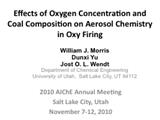 |
Effects of oxygen concentration and coal composition on aerosol chemistry in oxy firing | 2010-11-12 | aerosol chemistry; oxy firing; ICSE; coal aerosols; coal composition | Outline: 1) Objectives 2) Coals examined 3) Furnace, sampling, and analysis 4) Results 5) Conclusions. The objectives of the presentation is to provide a comparison of three different coal aerosols under two different oxy fired scenarios for predicting effects of coal composition on oxy firing. Exam... |
| 24 |
 |
Subtask 6.1: Engineering process models for economic impact analysis | 2011-03-10 | engineering process models; economic impact analysis; domestic heavy oil; developing domestic heavy oil/sands/shale resources | A presentation given at the Unconventional Fuels from Oil Shale and Oil Sands Project Review Meeting on March 10-11, 2011. In the project objectives, the purpose of assessment is to "Examine limiting factors to the development of domestic heavy oil, oil sands, and oil shale resources. Identify poli... |
| 25 |
 |
Subtask 4.3: Multiscale thermal processing of oil shale | 2011-03-10 | thermal processing; oil shale; oil shale treatment; thermal treatment |
